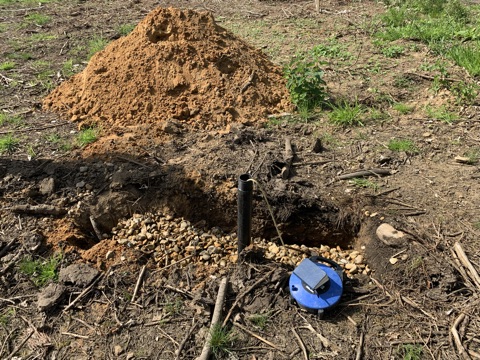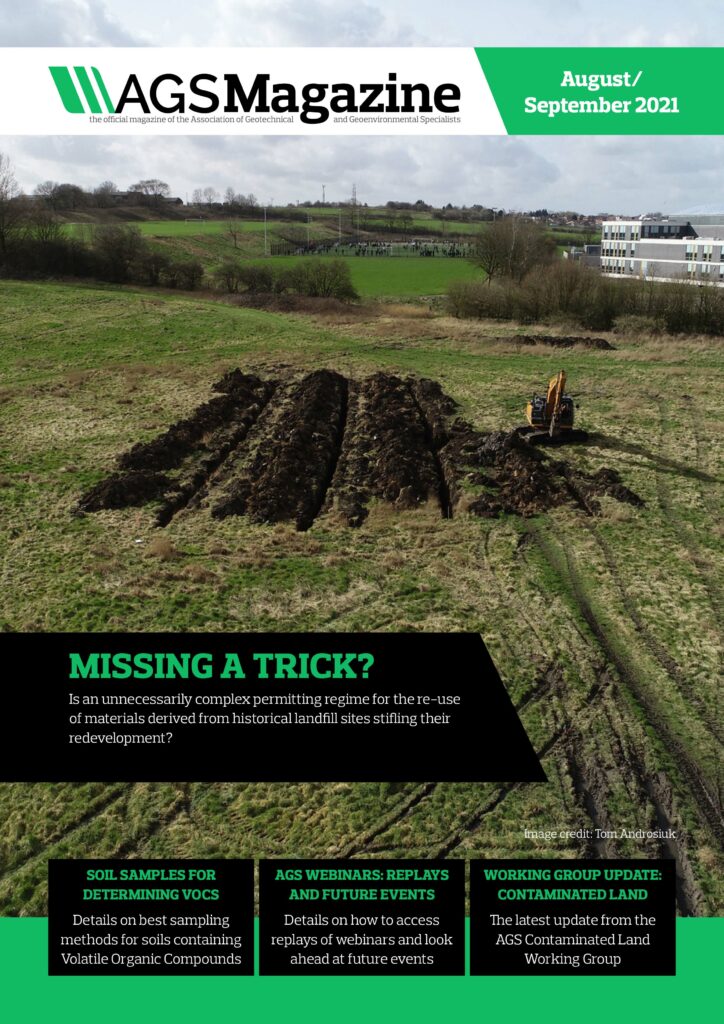
Image credit: James Harrison – 4D GEO LTD
Article by Georgina Donbroski (Technical Director at Leap Environmental Ltd), James Harrison (Director at 4D Geo Limited) and Alex Dent (Associate Director at WSP)
Firstly, with respect to Health and Safety matters, it should be noted that CDM Regulations place duties on both the designer (of the ground investigation, including scheduling soakaway tests) and the contractor who will be implementing the tests. Based on CDM requirements, the following considers the ERIC principle, of Eliminate, Reduce, Improve and Control.
As with any site investigation process, a phased approach makes the most sense. A good desk study should be able to ascertain the feasibility for infiltration systems to work on site and hence the potential requirement for BRE365 testing. Consideration must be given not only to the potential infiltration rates achievable, but also the potential for contaminated land and/or groundwater, flood risk, winter (maximum) groundwater levels, designation of the groundwater resource, potential for ground instability etc, any of which may have a significant impact on the feasibility of the use of infiltration based drainage systems.
CIRIA C753 SUDs manual outlines how the above should be considered at the conceptual design stage, and encourages a preliminary assessment using desk based sources. Assuming no other constraints exist, C753 also gives some preliminary infiltration ratings (good/poor/very poor/other) based on soil type and notes that where infiltration rates of 10-6m/s of higher are anticipated (clays, clayey ‘loams’, structureless chalks), then an infiltration scheme may not be viable.
Thus we can eliminate (ERIC) unnecessary testing at an early design stage. The elimination of unnecessary testing is clearly desirable, not only in terms of cost savings for the client but also from a Health and Safety point of view, especially when one considers the specific health and safety issues associated with soakaway testing (deep excavation and water).
Assuming the desk study indicates an infiltration based drainage system may be feasible, then is the phase 2 investigation a good time to undertake BRE365 testing? Possibly not. Do you know the maximum groundwater level, the detailed scheme layout, final ground levels, proposed location of SUDs? If not, then perhaps it is still too soon to undertake large scale testing. C753 states that “groundwater levels should be investigated to ensure the base of the proposed infiltration component is at least 1m above the maximum anticipated groundwater level (taking in to account any seasonal variations in levels and any underlying trends)”, and a greater unsaturated zone may be required by the Environment Agency if your site is located within a groundwater source protection zone.
It is also critical for detailed design that the BRE365 test undertaken accurately replicates the zone of infiltration proposed for the final design. An infiltration rate obtained from 2m head of water in a 3m deep trial pit will not provide an appropriate infiltration rate for permeable paving. Similarly, a 1m shallow soakage test will not provide a suitable infiltration rate for permeable paving design if ground levels are to be significantly reduced. And finally, particularly for sites where the infiltration potential is borderline and interbedded soil types are predominant, then testing at your proposed infiltration component location will be critical to obtain representative parameters for design.
So what can we do at the Phase 2 stage? Unless you can prove groundwater at depth, then groundwater monitoring is key, and where groundwater is potentially high, more and more local authorities are insisting on winter monitoring. We are also at an ideal stage to classify our soils using relatively cheap laboratory classification testing (PIs and PSDs), which will enable us as designers to more accurately estimate potential infiltration rates. Preliminary testing may also be undertaken in boreholes, but the results should be used with caution, noting the smaller volume of water used, the potential for smearing of the borehole sides, depth tested and the need to still test 3 times. BRE365 tests can be undertaken at this stage, but the client should be made aware that unless the testing is at the correct depth and location, additional BRE365 test should be required at the detailed design stage.
Having established the site is suitable and the type and specification of your infiltration system, then BRE DG365 sets out the method for obtaining the design soil infiltration rate. Testing is usually within trial pits, which should be undertaken in accordance with the AGS Guidance on the safe excavation of trial pits. BRE365 notes the pit should be to the same depth as the proposed soakaway, and 1-3m long and 0.3-1m wide, vertical trimmed sides, square and if necessary, for stability, filled with granular material. Noting that only pits within clay soils or rock may be stable (even this is not a given), and that clay soils should have been deemed unsuitable during the desk study phase, then arguably most pits will need to have a granular backfill to adhere to the BRE DG365 methodology.
Providing a granular backfill also acts to reduce risk (ERIC) by: significantly reducing the likelihood of trial pit collapse to the short period it remains open; removing the presence of open water filled pits; and enabling greater ease of measurement of water levels via the slotted pipe installed for monitoring. It also enables testing to continue safely beyond a single day, removing the potential for open pits on site.
Granular backfill may be delivered to site in large bulk bags of pea shingle, enabling the excavator to easily move these to test locations. The monitoring pipe is placed within the trial pit (end covered with a bulk bag to prevent infilling), and the base of the shingle bag split to pour the gravel directly into the pit. Above proposed invert level, the pit may be backfilled with arisings and the topsoil and turf re-laid if further testing may be required. If trial pits are deemed stable when water is added, for example in competent chalk, then the trial pit should be covered to minimise/improve (ERIC) the risk of working next to open water, typically with a Heras fencing panel, prior to testing. Open pits should secure, not be left unattended for any period of time and must be backfilled immediately once testing is complete. Testing must only be undertaken by suitably trained and qualified staff, controlled (ERIC) under the Safe Systems of Work defined in the RAMs.
Like any geotechnical design, parameters obtained from testing must first be used accordingly. The infiltration rate is an empirical measurement which should be calculated as defined in BRE DG365 (with due regard to the use of gravel). If it is not possible to carry out a test to the full depth of the pit, the guidance is clear that the results may be calculated based on the time for the fall of water from 75%-25% full of the actual maximum water depth achieved, with a similar correction for internal surface area. Results should not be extrapolated to empty. Secondly, the results must not be viewed in isolation, and must be given due consideration with respect to all the other factors known on site. For example, an infiltration rate c10-4m/s obtained on a site known to be underlain by silty clayey sand or ‘loam’ is indicative of some other factor influencing the local infiltration rate. Either the ground model is wrong, or some other factor, such as a void, made ground, service trench etc are influencing the result. Geotechnical design requires experience and training, and the selection of design parameters is critical to providing a sustainable design, including for SUDs.
So in summary,
- Just like any aspect of geotechnical design, a phased approach to investigation (comprising desk study, preliminary investigation and detailed investigation) should be standard practice.
- Just like any other aspect of geotechnical investigation due consideration should be given to Health and Safety issues by all parties.
- If a GI contractor is proposing to undertake soakaway testing without use of gravel backfill (or if this is unclear) this should be queried with them at tender stage.
When client (or their advisors) are requesting soakway testing, it should be queried as to whether suitable desk study research has been undertaken. Where this is being driven by a third party and being requested counter to the findings of desk study, for example to prove a negative to a LLFA or local drainage board, they should be reminded of the Health and Safety risks that they are introducing by demanding a test that puts personnel (and perhaps the public) at risk for very little or no technical benefit. Perhaps in this situation, if boreholes are being formed anyway for foundation design purposes, consideration could be given to testing based on BS EN ISO 22282-2:2012 Section 6.1.4 (which is also referred to in the SuDS Manual).
All good construction practice comes from experience and learning from others, including mistakes and near misses. The authors would be pleased to hear members experience on BRE 365 soakage testing. Have you had any near misses? Do you use any alternative methods for assessing infiltration? Have you had occasion to test infiltration systems and compare with original design parameters?
References
CIRIA Report C753 ‘The SuDS Manual’, CIRIA 2015
BRE DG365 ‘Soakaway Desgin’, BRE, 2016
BS EN ISO 22282-2:2012 ‘Geotechnical Invetigation and Testing – Geohydraulic testing. Part 2: Water Permeability testing in a borehole using open systems’, BSi, 2012

